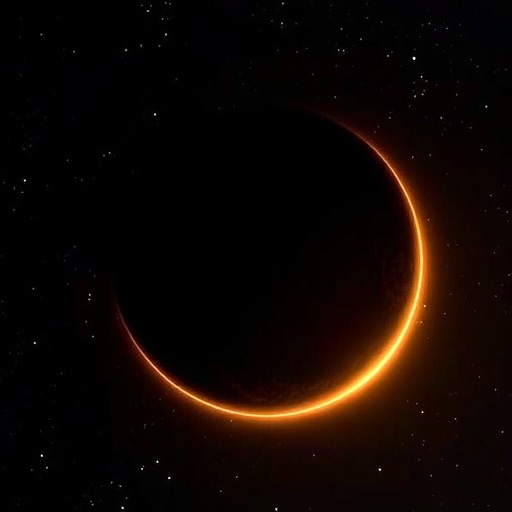A groundbreaking discovery has emerged in the field of astrophysics, unveiling astonishing insights into the growth patterns of rogue planets. Approximately 620 light-years from Earth, astronomers have observed a young rogue planet, designated Cha 1107-7626, experiencing an unprecedented growth phase. This celestial body, which is estimated to be five to ten times more massive than Jupiter, is notable for not orbiting any star. Instead, it operates independently, dramatically illustrating the complexities of planetary formation beyond traditional star-centric systems.
Utilizing the capabilities of the European Southern Observatory’s Very Large Telescope, researchers have recorded an extraordinary accretion rate of six billion tons of gas and dust per second. This astounding figure represents the fastest accumulation rate ever documented for any planetary-mass object. The observations suggest that the mechanisms driving this growth may involve strong magnetic fields, a characteristic usually reserved for stars, thus expanding our understanding of planetary genesis.
The initial observations captured the rogue planet in a rapidly evolving state, enhancing our comprehension of how such isolated planetary entities forge their existence from the surrounding cosmic material. This startling growth phenomenon diverges from conventional notions that often characterize planets as stable and tranquil environments. Instead, researchers confirm that Cha 1107-7626 is in a dynamic phase of evolution, actively interacting with its surrounding accretion disk, which consists of dust and gas.
Ray Jayawardhana, a senior co-author and professor at Johns Hopkins University, expressed excitement over this rare glimpse into the early life of what he described as “newborn rogue planets.” He emphasized the vibrancy of these planets’ formative stages, revealing that they may navigate through turbulent periods of growth comparable to those experienced by young stars. This discovery holds significant implications for understanding the overall processes involved in planetary formation and growth.
The data collected present a compelling case for the functionality of magnetic fields in channeling material from the surrounding disk onto the rogue planet. This finding is particularly notable as it aligns closely with the behavior observed in young stars, adding a layer of complexity to our conceptions of planetary and stellar development. Víctor Almendros-Abad, the lead author of the study, underscored the novelty of this observation, claiming it exemplifies how planetary-mass objects, which are typically seen as dormant, can exhibit remarkably vigorous states.
Furthermore, the research indicates a transformation in the chemical composition of the material surrounding the planet during this rapid growth phase. Notable studies involving data from the James Webb Space Telescope have revealed the presence of water vapor in the disk, a significant finding that distinguishes the growth spurt period from earlier observations. This serves as a crucial marker in understanding the environmental shifts accompanying the planet’s intense accretion activity.
In the broader context of astrophysical phenomena, the similarities between the growth patterns of rogue planets and stars challenge existing paradigms. Jayawardhana pointed out that the research highlights a compelling parallel between these massive entities, suggesting that giant, free-floating planets may form in much the same manner as stars. They appear to evolve from gas and dust clouds, accompanied by their own significant accretion disks, mirroring the processes long attributed solely to stellar bodies.
This discovery not only enhances our understanding of rogue planet dynamics but also raises intriguing questions regarding the potential for life and the formation of planetary systems in unconventional circumstances. The chaotic and energetic nature of Cha 1107-7626’s accretion process invites wider considerations of how such worlds might support or interact with potential biospheres, should conditions eventually stabilize.
As a new chapter in planetary science unfolds, the scientific community will undoubtedly be inspired to explore these enigmatic objects further. The findings have been documented for publication in the esteemed Astrophysical Journal Letters, ensuring their place in the ongoing discourse regarding planetary formation, growth, and the myriad possibilities within our universe.
Researchers are keen to continue monitoring the behaviors and characteristics of Cha 1107-7626. This rogue planet represents not just an exciting case study but a window into the potential diversity and dynamism of planetary systems beyond the conventional frameworks. Each new piece of information unearthed about this rogue planet contributes to a more comprehensive narrative about the cosmos and humanity’s place within it.
The implications of this research extend well past the immediate findings, resonating across various scientific fields. Astrophysicists, planetary scientists, and even scholars in related disciplines will find that studying rogue planets like Cha 1107-7626 could reshape our understanding of formation processes in the universe, influencing everything from theoretical constructs to observational strategies and future exploratory missions that seek to uncover the mysteries of our cosmos.
Subject of Research: Growth of rogue planets
Article Title: Discovery of an Accretion Burst in a Free-Floating Planetary-Mass Object
News Publication Date: [Insert Date]
Web References: [Insert Links]
References: [Insert List]
Image Credits: ESO/L. Calçada, M. Kornmesser
Keywords
Rogue planets, Cha 1107-7626, accretion, planetary formation, astrophysics, cosmic observations, stellar processes, magnetic fields.




